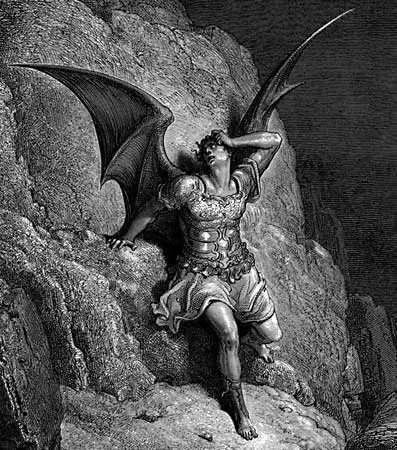Get ready to peel back the layers and uncover the real story of Lucifer—the one buried beneath the myths and misinterpretations. We’ll dive into the Bible and dig deep to reveal the truth about this enigmatic figure. By exploring these biblical texts, we’ll gain a fresh perspective on Lucifer, seeing beyond the popular images and understanding the deeper meaning of his story. Let’s step into the world of ancient scriptures and theological interpretations to uncover the true nature of Lucifer and his role in the grand scheme of things.
Lucifer Before the Fall: A Glimpse into His Former Glory
Let’s talk about Lucifer, the infamous fallen angel. Before his rebellion, he was like the shining star student of heaven. We’re talking seriously dazzling, bursting with wisdom, and holding a top-tier position among the angels. Think of him as God’s right-hand angel, guarding the very presence of the divine.
What Led to Lucifer’s Downfall?
So, what happened? It’s a classic tale of ego gone wild. Lucifer got a taste of his own awesomeness and decided he wanted more, way more. He wasn’t content with power; he craved the kind of worship only God deserves. This ambition led to a full-blown rebellion, shattering his bond with the divine.
The Consequences of Lucifer’s Rebellion
God wasn’t about to let Lucifer’s rebellion slide. Lucifer was banished from heaven, cast down from his exalted position. This marked a turning point; he went from Lucifer, the light-bearer, to Satan, the ultimate adversary.
Satan: Master of Deception and Temptation
Now, as Satan, he’s like a super-smart but devious chess master, always scheming and whispering temptations, trying to thwart God’s plans. He’s powerful, no doubt, but ultimately, God’s calling the shots.
The King of Tyre: A Reflection of Lucifer’s Fate?
There’s an interesting parallel in the Bible between Lucifer’s story and the “King of Tyre.” Some scholars suggest this king is a metaphor for Lucifer’s downfall – both consumed by their own self-importance. It’s like seeing the same story play out on different stages, one earthly, one spiritual.
Unraveling the Mystery of Lucifer’s Appearance
When you dig deeper into Lucifer’s story, things get even more fascinating. The Bible is pretty vague on his physical appearance, which makes you wonder about the true nature of these celestial beings. Maybe it’s more about character than looks in the spiritual realm?
Pride and Humility: A Timeless Battle
Comparing Lucifer’s actions to the unwavering loyalty of other angels highlights just how insidious pride can be and how essential humility is. It’s a timeless battle of good versus evil, playing out both in the Bible and within ourselves.
Unmasking Lucifer: How He’s Described in the Bible
We’ve already touched on some key points, but let’s really dive into how the Bible describes Lucifer. Picture this: Lucifer was like the brightest star in the sky, a radiant angel in the highest ranks of heaven. His name actually means “shining star” or “light-bearer,” which shows just how important and glorious he was.
The Fall from Grace: Pride’s Destructive Power
However, even with all that, Lucifer let pride and ambition take over. He dared to challenge God, which sparked a massive rebellion. Can you imagine the upheaval? This wasn’t just a small disagreement; it caused a whole rift in heaven! Lucifer, followed by a band of rebellious angels, was cast out. That’s when he became known as Satan, the ultimate adversary.
From Light to Darkness: The Transformation of Lucifer
From then on, his whole deal became tempting people and pointing fingers, trying to cause as much trouble as possible. Now, you might be curious about what Lucifer actually looked like. However, the Bible keeps that part a bit of a mystery.
The Importance of Character over Appearance
Some theologians believe this is because the Bible wants us to focus on Lucifer’s inner being—his personality and motivations. It’s not about his looks; it’s about the pride, the cunning, and that burning desire to take God’s place that truly defined him.
A Timeless Warning: The Dangers of unchecked Ego
Lucifer’s story is like a big warning sign about what happens when ego and ambition spiral out of control. It reminds us that going against God’s will leads to serious consequences. Instead, we should strive for humility, listen to God’s guidance, and remember that relying on him is always the best path.
Unmasking the Devil: What Does the Bible Say About His Appearance?
We often picture the Devil with horns, a pointy tail, and a pitchfork. However, the Bible doesn’t really paint that picture. It’s more interested in telling us about the Devil’s deceitful personality and his ability to blend in.
The Art of Deception: Hiding in Plain Sight
Think about it: to be really good at tricking people, you wouldn’t want them to know who you really are, right? One of the most intriguing things the Bible tells us is that the Devil used to be called “Lucifer,” which means “morning star.” It’s a stark contrast to the being he is today!
The Angel of Light: A Master of Disguise
Even more surprising is that the Bible actually warns us that the Devil can appear as an “angel of light.” That means he might not look scary at all. He might even seem kind and trustworthy, which makes him even more dangerous because it’s easier to trick someone you think is on your side.
The Serpent’s Deception: A Lesson from the Garden
Remember the story of Adam and Eve in the Garden of Eden? The Devil appeared as a serpent, and he used smooth words and promises to tempt them. This shows us that the Devil is a master of disguise, and he’s not afraid to use beauty or charm to get what he wants.
Exploiting Our Weaknesses: The Devil’s Tactics
He’s also really good at exploiting our weaknesses. Are we easily tempted by power? Do we crave pleasure or knowledge that’s off-limits? The Devil knows these things about us, and he uses them against us.
Protecting Ourselves: Discernment and Truth
So, how do we protect ourselves? The Bible tells us to be wise and learn how to spot a fake. It encourages us to compare everything we see and hear with what we know to be true from the Bible. That way, we can avoid falling for the Devil’s tricks. It’s like having a built-in lie detector!
Understanding the Enemy: Beyond Physical Appearance
It’s important to remember that while the Bible doesn’t give us a physical description of the Devil, it gives us something much more important: an understanding of his character and tactics. It helps us understand that the Devil is real, he’s sneaky, and he’s always looking for a way to trip us up. But, with a little knowledge and a lot of caution, we can see through his deceptions and stay on the right path.
Lucifer’s True Name: Unraveling the Mystery
We’ve delved into the story of Lucifer, this mysterious figure who went from top-tier angel to, well, not so much. But a burning question remains: what was his name before his fall from grace?
The Bible’s Silence: A Name Lost to Time?
The Bible, our primary source for all things angelic, remains quite vague. It calls him “Lucifer,” which translates to “light-bringer” or “morning star.” It’s a name that suggests he was once a being of great importance and brilliance.
However, when it comes to his name from before the falling-out-with-God scenario? The Bible doesn’t explicitly say.
Isaiah 14:12-15: A Possible Clue?
Some scholars have been digging through ancient texts and scriptures, trying to piece together clues. One popular theory points to a passage in Isaiah 14:12-15. This section talks about a “morning star” who falls from heaven due to excessive pride. Some experts believe this is referring to Lucifer and that his original name might have been “Helel,” which is Hebrew for “shining one.” It’s a theory that has gained some traction.
Jewish Mysticism: Another Name Enters the Ring
Jewish mysticism, with its rich tapestry of stories and interpretations, offers another possibility: “Samael.” Now, Samael is often depicted as a rather intense figure, associated with concepts like death and destruction. Given Lucifer’s later actions, some people believe this could be a match.
The Mystery Remains: A Name Shrouded in History
In the end, Lucifer’s true name before his fall remains a mystery. While we may never know his original name, we know that Lucifer experienced a monumental fall from grace. His story serves as a stark reminder that pride and ambition can corrupt even the most brilliant of beings.
Here’s what we know:
- “Lucifer” translates to “light-bringer” or “morning star,” hinting at his former glory.
- The Bible doesn’t directly state Lucifer’s first name.
- Isaiah 14:12-15 could be about Lucifer and suggests “Helel” as a possibility.
- Jewish mystics propose “Samael” as another option, based on his later role.
- Lucifer’s rebellion and expulsion from heaven are the central points of his story.
Unmasking the Angels: What Does the Bible Call Them?
We’ve spent a lot of time talking about angels, those heavenly beings we often encounter in the Bible. You might be picturing glowing figures with feathery wings, but the Bible paints a picture that’s a bit more intense. It’s not as simple as giving them all one name. The Bible describes a heavenly hierarchy with various ranks and names, a bit like a celestial organizational chart.
A Heavenly Hierarchy: Different Roles, Different Names
Think of it this way: in the human world, we have different titles for different jobs, right? We have teachers, doctors, artists—each with their own area of expertise. Well, the angelic realm is similar. Different types of angels have specific roles and responsibilities.
The Highest Ranks: Angels of Power and Praise
- Seraphim: These angels are like the VIPs of heaven. They’re described as having six wings and their main job is to constantly praise God. Talk about dedication!
- Cherubim: These powerful beings are often depicted with multiple faces and wings, serving as divine guardians. They’re all about upholding God’s holiness.
- Archangels: These are the big names like Michael and Gabriel. They’re essentially the leaders of the angelic world, delivering important messages and commanding heavenly armies.
“Lucifer”: A Name Misunderstood
There’s a common misconception about a certain fallen angel named “Lucifer.” The name “Lucifer” doesn’t actually refer to a fallen angel in the Bible itself. It comes from a specific translation of Isaiah 14:12, and in that context, it’s talking about the king of Babylon’s fall from grace, not Satan’s.
Angels: Stranger Than We Imagine
One thing’s for sure, biblical angels are definitely not the human-looking figures you often see in paintings and movies. The Bible describes them as beings of incredible power and otherworldly appearances. For example, the prophet Ezekiel had a vision of these amazing creatures with four faces – a man, a lion, an ox, and an eagle – and they were covered in eyes! And get this, they had these crazy whirling wheels around them. Talk about a wild sight!
Then you have the prophet Isaiah’s encounter with the Seraphim, those six-winged beings whose voices were so powerful, they shook the very foundation of the temple.
Unmasking the Angels: Beyond Human Perception
When it comes to biblically accurate angels, there’s a lot more to them than we might think. They’re diverse in their appearance, their roles, and even their names. They’re not just there to look pretty; they’re powerful beings with essential responsibilities in the divine order of things.
Explore Further:
- The history of does Northern Ireland believe in fairies and leprechauns is full of mystical creatures and magical folklore.
- Take a sneak peek into the world of spirituality and learn about Judeosufi.
- Enjoy a thrilling adventure by understanding the dark and darker stairs exit plan and experience the excitement of the game.
- Unlock Water’s Symbolism: A Cross-Cultural Exploration - April 20, 2025
- Identify Black and White Snakes: Venomous or Harmless? - April 20, 2025
- Unlocking Potential: Origins High School’s NYC Story - April 20, 2025















